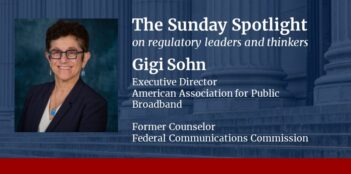
FCC Chair emphasizes need for increased consumer choice in the years to come.
Americans need more choices for faster and better Internet service. That was the message of Federal Communications Commission (FCC) Chairman Tom Wheeler, speaking earlier this month to the Washington, D.C.-based organization 1776, a group that describes itself as a “global platform for connecting entrepreneurs.”
In prepared remarks released by the FCC, Wheeler documented that fewer than 15% of households have access to more than two broadband providers offering download speeds of just 4 megabits per second (Mbps).
“[L]et’s be clear,” Wheeler stated, “this is yesterday’s broadband.” Downloading a single HD video to a home or classroom currently requires a minimum of 5 Mbps of capacity, according to Wheeler.
As Internet speeds increase, competition among providers sharply declines. A full 82% of homes have no more than one provider offering download speeds of 50 Mbps.
Wheeler’s remarks came at a time when consumer demand for Internet connectivity has never been higher. Today, he said, “It’s not uncommon for a U.S. Internet-connected household to have six or more connected devices.” Even televisions now come with the capacity to connect directly to the Internet. And more than 60% of peak-time downloads are streaming audio and video, which absorb the most bandwidth.
That is why, as Wheeler put it, “[a] 25 Mbps connection is fast becoming ‘table stakes’ in 21st century communications.”
Yet for a majority of American homes—roughly 60%—it is not access to high-speed Internet that is the problem. Instead, it is the fact that so many homes have access through only one provider.
With no competition, providers are able exert increased price and bandwidth control. Part of the problem, Wheeler noted, is that in many cases broadband providers have unrestrained “last-mile” power. In other words, the infrastructure and services that ultimately deliver Internet access to consumers are too often controlled exclusively by a single broadband provider.
This is not a new problem. In the early 1990s, cable companies were accused of manipulating the market for cable services to restrain competition. Then, Congress stepped in and adopted the Cable Television Consumer Protection and Competition Act of 1992.
In the process, Wheeler claimed, two important lessons were learned. The first was that “last-mile power cannot be a lever for gaining an unfair advantage,” he said. The second lesson was that regulatory guidance can encourage investment and innovation.
For these reasons, Wheeler concluded that “public policy can step in to protect consumers and innovators.”
Wheeler proposed a four-part plan to increase broadband competition. Dubbed the “Agenda for Broadband Competition,” Wheeler’s plan is a mix of regulatory and market-based initiatives designed to encourage competition among broadband providers.
Citing the Commission’s efforts to oppose reducing the number of nationwide wireless providers, as well as a recent order to permit experiments to learn more about the impact of technological transitions in rural America, Wheeler affirmed the FCC’s position that “changes in network technology should not be a license to limit competition.”
His remarks suggest that the Commission will aggressively regulate to ensure that competitiveness in today’s broadband market does not recede. This is consistent with the FCC’s National Broadband Plan, a comprehensive strategy to advance, among other things, consumer welfare.
In addition, Wheeler hinted at an intention for the FCC to use regulation to promote still greater competition. As an example, he cited the Commission’s Open Internet order establishing “high-level rules requiring transparency and prohibiting blocking and unreasonable discrimination to protect Internet openness.”
When the order was challenged in federal court, the FCC vigorously defended it. The United States Court of Appeals for the District of Columbia Circuit ultimately affirmed the order.
Wheeler further cited Commission efforts to “expand the amount of unlicensed spectrum” as a process through which “alternative competitive pathways” are generated. These efforts, along with other FCC initiatives aimed at stimulating competition, are crucial governmental responsibilities, according to Wheeler. “We must build on and expand the creative thinking that has gone into facilitating advanced broadband builds around the country,” he said.
Such “broadband builds” include Google’s expansion into the fiber optic broadband market with Google Fiber. This technology, slated to be installed first in Kansas City, Austin, TX, and Provo, UT, with nine other major cities to follow, will offer Internet speeds more than one hundred times faster than traditional broadband.
Wheeler insisted that collaborative efforts between federal, state, and local governments will be important in facilitating further broadband investment along these lines.
Finally, Wheeler stated that just because “something works in New York City doesn’t mean it works in rural South Dakota.” A failure to promote competition everywhere could create a “digital divide” between residents of major metropolitan areas and individuals living in less developed regions of the country.
Overall, meeting the challenge of increasing broadband competition, both to expand consumer choice and spur infrastructure investment and innovation, promises potentially enormous impacts on the future. Because nearly every facet of American life is impacted by Internet connectivity, each new development stands to make significant impacts on consumers’ experiences.
The key to securing the full benefits of technological innovation will be broadband competition—the “North Star,” according to Wheeler.
Wheeler concluded on an optimistic note, observing that the same country where the Internet was invented could rise to meet the future challenges of securing robust broadband competition.



